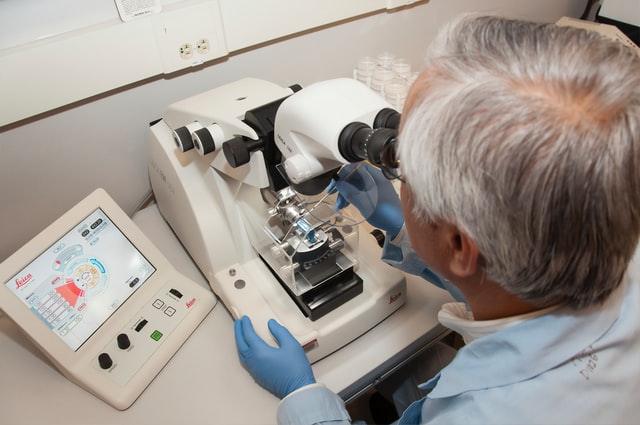If you have access to a phosphorylation reaction, you can use it to learn about protein phosphorylation. Phosphorylation is the process by which a phosphate group is added to proteins by enzymes known as kinases. This process of adding an inorganic phosphate after the addition of ADP is referred to as protein phosphorylation.
Protein phosphorylation is constantly happening in our bodies and is essential for some processes that involve the biological activity of proteins. Because so much of how we function depends on phosphorylated proteins, protein phosphorylation can be considered a vital process for life and the continuation of organic functions.
Cell Cycle
The cell cycle, also called the cell division cycle, is a complex series of events that results in a new cell.
Some of the key steps in the process include:
DNA replication: This is when DNA is copied and duplicated for a new cell.
G1 (gap phase 1): This is when the cell is preparing to divide and growing.
S phase (synthesis phase): This is when DNA is being copied.
G2 (gap phase 2): This is when proteins are used to gather and reorganize DNA for cell division.
Mitosis: This is when the nucleus divides, resulting in two identical cells.
Cytokinesis: This is the final stage of mitosis, where the cytoplasm divides into two new cells.
Cell Death
Cell death, or apoptosis, is a genetically programmed process for the elimination of unwanted cells in multicellular organisms. It is characterized by several features of cell shrinking, including a marked decrease in cell size, condensation and margination of chromosomal DNA, formation of apoptotic bodies and subsequent removal of the cell fragments.
Apoptosis may be triggered by multiple stimuli. These include growth factor withdrawal, treatment with anticancer drugs and exposure to ionizing radiation. The process involves both enzymatic (caspase) and nonenzymatic pathways. The latter include activation of protein kinases (JNK and p38) and phosphorylation of Bcl-2 family proteins such as Bad.
Signal Transduction
Signal transduction is the process by which extracellular signals (e.g., hormones, neurotransmitters) are converted into intracellular changes that elicit a biological response.
Signal transduction involves many signaling pathways, each of which includes several steps:
1) A signaling molecule (ligand) binds to its receptor on the cell surface or within the cell
2) The receptor undergoes a change in conformation (shape)
3) This conformational change activates an effector protein
4) The activated effector protein then activates its next target protein, which may be a transcription factor or an enzyme.
Enzymes generally act upon their substrate molecules to add a phosphate group, remove a phosphate group, or cleave a bond between two phosphates (hydrolyze). Protein phosphorylation by enzymes is often the final step in signal transduction and causes an increase in enzymatic activity.
Phagocytosis
Phagocytosis is a process where certain cells (e.g., macrophages, neutrophils) engulf large foreign particles, such as bacteria and fungi. It is very important for the defense mechanisms of our body.
Phagocytosis is a complex process that requires the coordinated action of many proteins. The following steps are involved in phagocytosis:
1) Recognition of the foreign particle by the cell surface receptors
2) Formation of pseudopods around the foreign particle
3) Adhesion of the pseudopods to the foreign particle
4) Internalization of the foreign particle by formation of a phagosome
5) Fusion of lysosomes with the phagosome to form a phagolysosome
6) Fusion of the phagosome with lysosome and subsequent degradation of the engulfed material.
The process of phagocytosis is regulated by protein phosphorylation at different steps. For example, phosphorylation plays an important role in adhesion and fusion events in forming a phagosome.
Protein Translation
Protein translation, which is the process of synthesizing proteins from messenger RNA, requires protein phosphorylation. This reaction is catalyzed by transfer RNA and ribosomes, a complex of protein and catalase that are made up of 60% RNA and 40% protein.
The catalysts in this reaction require ATP to activate them and result in an increase in the concentration of free phosphate groups in cells. In addition to protein translation, phosphorylation is also required for the synthesis of DNA and mRNA.
These reactions take place when enzymes called transcription factors bind to specific regions on DNA known as promoter regions. They cause the gene that encodes for DNA repair enzymes to be expressed and these enzymes then bind to DNA repair sites on the genome and make modifications that result in the formation of new copies of these genes.
Last Words
Protein phosphorylation not only helps to regulate various biological processes, but it also creates incredible opportunities for scientists looking to understand and use these processes. With these opportunities come advancements that can prevent or treat many diseases, such as cancer. Perhaps the most exciting is its role in creating new methods of contraception that is both effective and safe. By improving our understanding of this process, we will be closer to utilizing protein phosphorylation for good.

